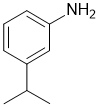Part 8: SPECTROSCOPY
The following data is available from the
question.
Note
: Remember to cross
reference things to confirm.... e.g.
IR may show C=C, use NMR to
confirm that etc.
MS: M+
seen at 135 g/mol, no m, m+2 pattern so neither Br nor Cl are present. Since 135 is an odd number, an odd number of N atoms are present.
IR:
There is a strong band near 1600cm-1 which is quite low for a C=O. At 3500-3300cm-1 there is a medium double absorption that suggests an - NH2. Bands either side of 3000cm-1 suggest both sp3 and sp2 C-H. There are absorptions of near 1500 cm-1 that could be C=C (Ar?).
13C NMR:
The normal proton decoupled spectrum shows a total of 8 peaks indicating 8 types of
C. By analysis of the chemical shifts, we have 6 peaks between 110-160 ppm (ArC) and peaks at 33 and 23 ppm that are
most likely from sp3 C hydrocarbon fragements. Note that there is NO C=O between 150-220ppm therefore it is not an aldehyde, ketone or any type of carboxylic acid or derivative.
1H NMR:
The proton spectrum shows a total of 6 sets of peaks indicating 6 types of H.
|
d/ppm
|
multiplicity
|
integration
|
Inference
|
|
7.2
|
t
|
1
|
ArH, CH coupled to 2H |
| 6.73 |
s
|
1
|
ArH, CH not coupled |
|
6.68
|
d
|
1
|
ArH, CH coupled to 1H |
| 6.55 |
d |
1 |
ArH, CH coupled to 1H |
| 3.7 |
s |
2 |
2H not coupled |
| 2.9 |
septet |
1 |
-CH- coupled to 6H slightly deshielded |
| 1.15 |
d |
6 |
(2 x -CH3) coupled to H |
(q = quartet, t = triplet, d = doublet, s = singlet)
The most significant structural information
from this are:
- adding integrals shows 9H (or a multiple thereof)
- it has a disubstituted aromatic (benzene)
- there are coupling patterns to decipher
Summary....
The MS indicated MW = 135 g/mol and N.
The IR showed the presence of -NH2
13C NMR suggests a disubstituted benzene system with 8 types of C
H NMR gives -CH-, -(CH3)2, and C6H4 (disubs. benzene)
This information suggests an initial molecular formula = C9H13N which gives MW = (9x12) + (13x1) + 14 = 135 which agrees with the MW from the MS.
Therefore, molecular formula = C9H13N which has an IHD = 4 consistent with the benzene system from the NMR.
Altogether...
|
The fragments we have are:

The IR showed an -NH2 which matches to the H-NMR 2H singlet at 3.7 ppm.
The H-NMR 1H septet at 2.9 ppm and the 6H doublet at 1.15ppm indicate an isopropyl group (CH3)2CH-
Now we have:

This means we are down to just 3 fragments and all that is left to do is establish the regiochemistry of the Ar region since we have a disubstituted benzene with two different substituents.

This is most easily done from the NMR. 6 types of ArC and 4 types of ArH, so it must be either ortho- or meta-. Since the aromatic region of the H NMR has 1 x t and 2 x d and 1 x s then it's meta-isomer (meta would have a second ArH triplet), so giving us the structure... |

m-isopropylaniline
|
The final step should always be to check what you
have drawn. The easiest thing to check is usually the coupling patterns you
would expect to see, and the chemical shifts of each unit. You should
be asking yourself : "Does my answer give me what the H-NMR shows ?"
Common errors:
MS missed the odd MW
IR missed the -NH2 and incorrect assumed a C=O was present (check the 13C NMR)
H NMR had hydrocarbon pieces that did not fit the integration and coupling patterns (esp. isopropyl group, degree of aromatic substitution and regiochemistry of the disubstituted benzene)
General
- did not check MW with data from MS
- did not check HNMR integration for number of H on the aromatic and hence had incorrect substitution of the benzene.
- did not check HNMR ArH coupling and hence had incorrect regiochemistry of the disubstituted benzene.
![[Home]](../mol.gif)




![[Home]](../mol.gif)